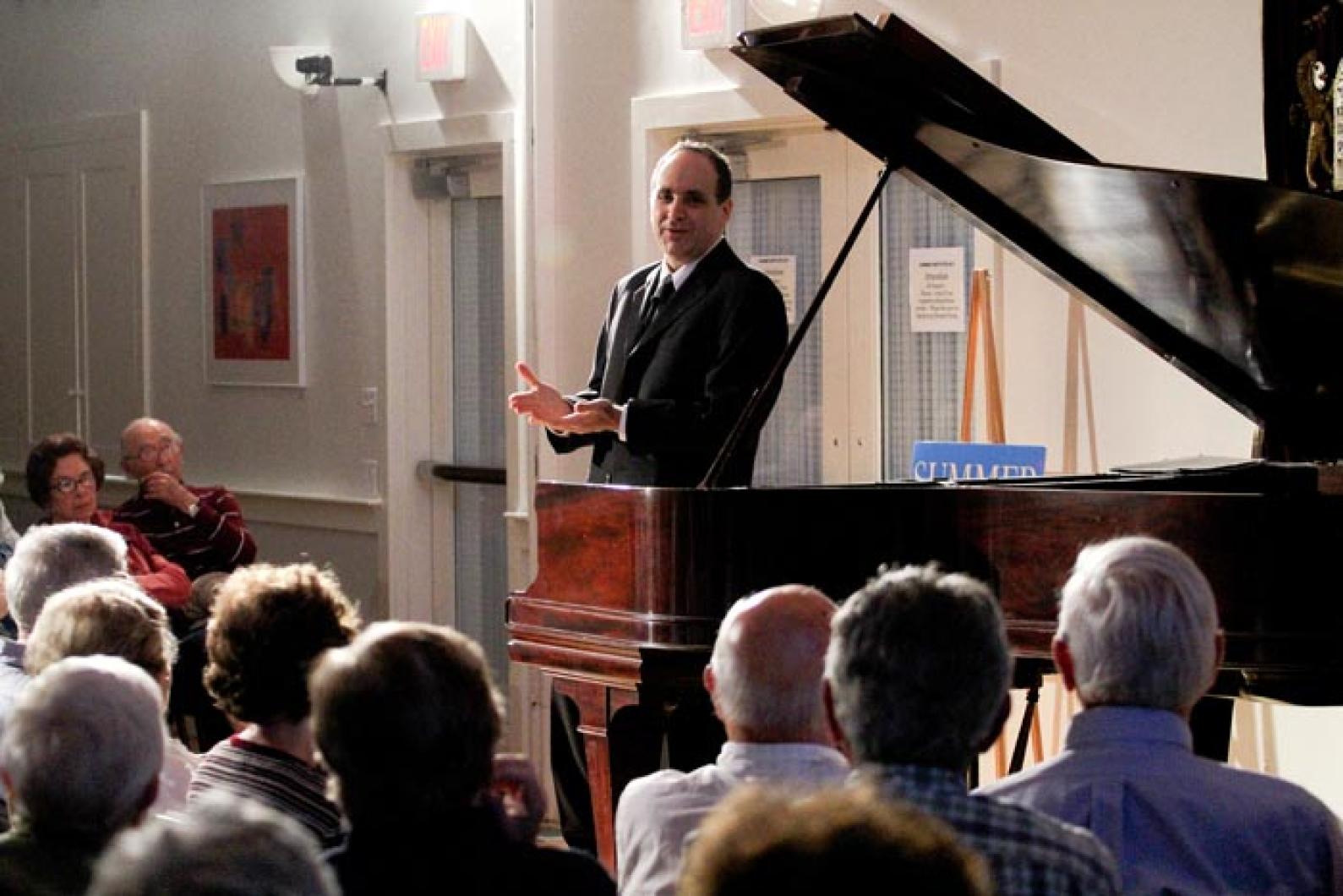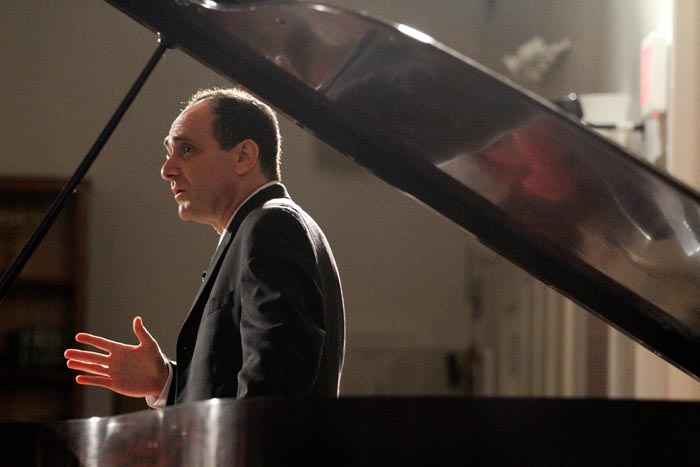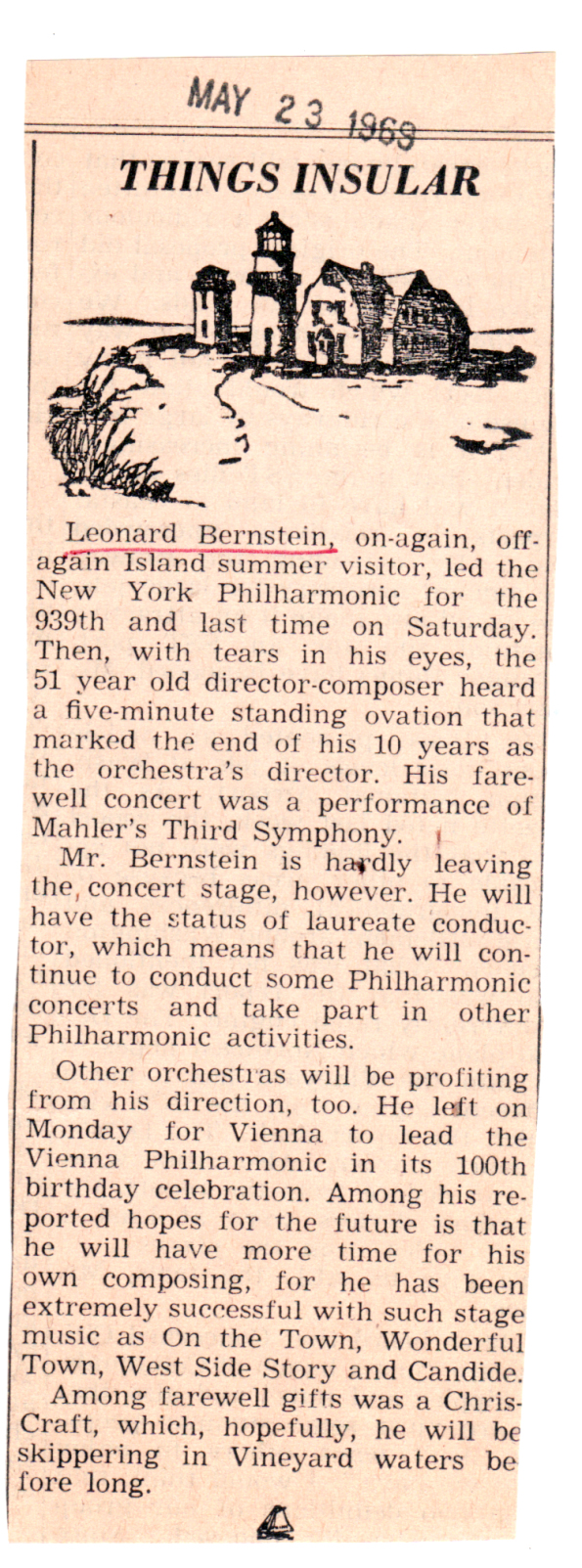The first time Leonard Bernstein laid his young fingers on the keys of a piano at the age of 10 he felt as though he had been touched by God.
He would sit at the piano, hour after hour, his father berating him to quit playing while his mother encouraged him to continue. Even growing up in a hostile environment with only his aunt’s piano as musical inspiration couldn’t stop him from becoming one of the most watched and listened to musicians in the world.
Perhaps even the greatest American musician, ever.
That’s precisely the theory concert pianist and psychiatrist Richard Kogan set out to prove to a packed house of musical theatre, pop music and classical composition fans at the Martha’s Vineyard Hebrew Center last Thursday night.
“Tonight I’m going to make [the case for] wthat I don’t think is even arguable, and that is that Leonard Bernstein is the greatest all-around musician that America has ever produced,” Mr. Kogan said. “He is a man of staggering versatility and accomplishments.”
Mr. Bernstein, a frequent summer visitor to the Vineyard, attended Harvard, and within a few years managed to accumulate an all star roster of mentoring musical luminaries, such as composer Aaron Copland, New York Philharmonic conductor Dimitri Mitropoulus and Boston Symphony conductor Serge Koussevitzky.
“His aggressive pursuit of musical father figures came as a result of his disappointment in own father’s failure to support musical ambitions,” Mr. Kogan said. “He was desperate for musical mentors, he didn’t even require mentors to be alive.
“In 1937 he heard the news that George Gershwin died. He walked over to the piano and he had this eerie sensation he was actually becoming George Gershwin.”
Gershwin combined jazz, pop, classical music; he was everything Bernstein hoped to be.
Even while traveling as a guest conductor across the world, Mr. Bernstein managed to spend time with theatre colleagues, notably Jerome Robbins. Together they wrote On the Town, a story of three sailors who try to fit in a lifetime of adventures during a 24-hour shore leave in New York city.
One song in particular, Mr. Kogan said, exemplified the pulsating vibe of the city but also offered a “portrait of a brash, charismatic young composer.” Mr. Kogan sat down at the piano and began to play New York, New York, his hands concentrating on the keys rather than the sweeping hand gestures he used when lecturing.
Mr. Kogan analyzed both Mr. Bernstein’s music career and many personalities, and noted his struggle with sexuality for years. After an on-and-off engagement with Chilean actress Felicia Cohn Montealegre, they finally married in 1951. He had a core group of women supporting him during this time — his wife, his sisters, his piano teacher — but was known to have male lovers through-out much of his life.
Mr. Bernstein was notorious for constantly pushing the envelope and seeking attention. He suffered from a hyperthymic temperament, bipolar disorder and histrionic personality disorder, Mr. Kogan said of his ecstatic states.
Super charismatic figures are prone to serious depression, Mr. Kogan said, and towards the end of his life Mr. Bernstein became unhinged. He died in 1990. Life was a personal dress rehearsal for Mr. Bernstein, Mr. Kogan said, and he never failed to impress.
Mr. Kogan said the years following Mr. Bernstein’s marriage, during which he was a frequent summer visitor to the Vineyard, were some of the musician’s most productive years.
Movements of Candide, the score for On the Water Front, and several concertos were composed at his home in Lambert’s Cove.
But Bernstein had a goal: He wanted to write, Mr. Kogan said, one large-scale theatrical work which would utilize the most sophisticated theory but be accessible to everyone. His friend Mr. Robbins 10 years earlier had talked about adapting Shakespeare’s Romeo and Juliet into a modern version for the stage.
The original vision was to focus on conflict between a Jewish girl and a Catholic boy during the Easter and Passover holidays, but with gang warfare suddenly prevalent, instead West Side Story looked at the rivalry between the Jets and the Sharks and the ill-fated romance between Puerto Rican Maria and Polish American Tony.
Mr. Kogan said Mr. Robbins insisted during production the actors in each gang not make contact with each other.
“He actually got them to hate each other,” Mr. Kogan said.
When it came to writing the score, a little known lyricist named Stephen Sondheim was paired with Mr. Bernstein. The two were originally billed as colyricists.
“These two were perfectly matched in terms of facility of language of music [but] they had totally different temperaments; Sondheim was an introverted pessimist, Bernstein a wildly extroverted optimist,” he said. “Bernstein’s versions [of songs] were invariably schmaltzy, corny rhymes everybody would cringe from embarrassment except for Bernstein. Most early Bernstein lyrics were discarded but some are still familiar.”
“You all know this song,” he said, and began to play the chorus of Tonight, Tonight.
“Tonight, tonight
The world is full of light
With suns and moons all over the place
Tonight, tonight
The world is wild and bright
Going mad
Shooting sparks into space”
“The lovers’ exhilaration in that song is pure Bernstein. I think Sondheim played the role in the professional relationship that Felicia played in the personal side; he was there reining in Bernstein’s creative impulses whenever they threatened to exceed the boundaries of good taste.”
Mr. Kogan said even with such a diverse score — everything from Officer Krupke to America to I Feel Pretty — there is still a strong sense of structural unity. He noted motifs throughout, especially the tritone interval.
Bernstein made tritones the base of West Side Story. The tritone, an interval that spans three whole notes, acts as a call to gang leaders in the story but it also serves as a moment of “interconvertability between love and hate,” Mr. Kogan said.
The producers hoped for a live recording, but Columbia Records refused to record it; their rejection letter said the scores were too depressing and there were too many tritones.
Mr. Kogan begged to differ.
“I consider this score to be the best score ever written for the American musical theatre,” he said.
Mr. Kogan then proceeded to sit down at the piano and play a heart-melting arrangement of every song from West Side Story. In one gesture the audience was transported to a back alley of New York city in 1961. Heads bopped and swayed with the rhythm of the music and a few people snapped their fingers, echoing the choreography of Mr. Robbins.
The ten-minute-long arrangement was like inhaling everything wonderful and heartbreaking about New York city and love in one breath, one that you never wanted to finish exhaling.









Comments
Comment policy »